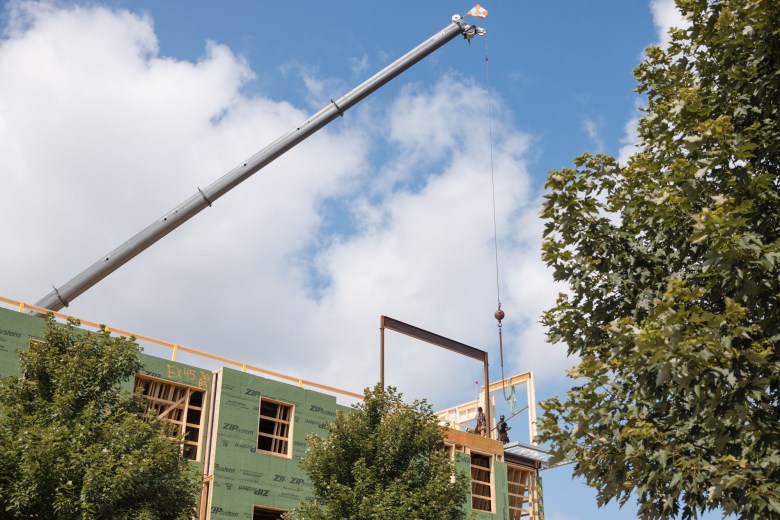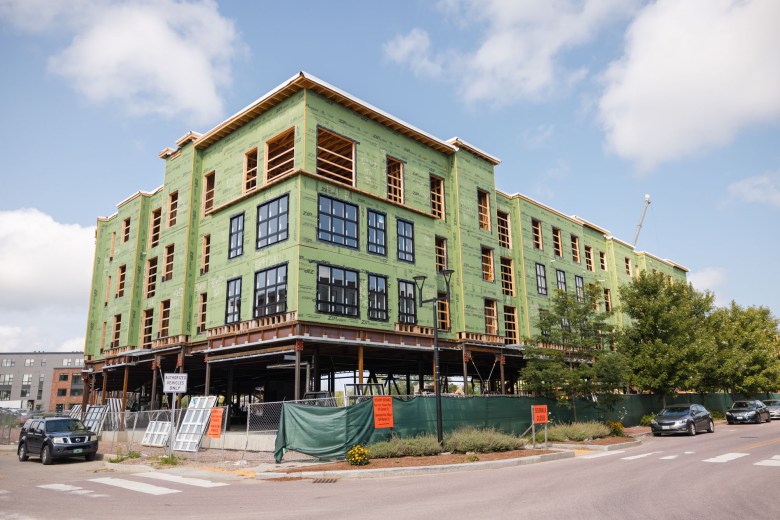BURLINGTON, Vt. — In his first year in graduate school at the University of Vermont, John Ball lived in a dark studio apartment in the basement of a building three miles from the campus.


With utilities, it cost him $1,500 a month — more than the national median rent.
“I just needed a place, and I was, like, OK, I’ll live anywhere, basically,” said Ball, who is working toward a doctorate in cellular, molecular and biomedical sciences. “Trying to find an apartment was a nightmare.”
Ball spoke as he was moving for the fall semester of his second year into a brand-new apartment in the first-ever housing to be built by the university for graduate students.
It’s one of a small but growing number of efforts by higher education institutions to address what has become, along with food, the fastest-growing cost of college: a place to live.
“I don’t think [students and their families] think it’s going to be as expensive as it is,” Ball’s father, Steve, said as he helped his son lug furniture and boxes into his new home, where monthly rents begin at $1,059 for a room in a three-bedroom apartment with two bathrooms. Housing prices at and near colleges, he said, have gotten “absolutely ridiculous. It’s insane.”
Like UVM, other institutions are building housing for graduate students who have previously been largely left to fend for themselves. Some, including the universities of California at Berkeley and Santa Cruz, are adding large numbers of undergraduate dorms. A few, like the University of Texas at Austin, are offering scholarships for housing.
Related: Become a lifelong learner. Subscribe to our free weekly newsletter to receive our comprehensive reporting directly in your inbox.
“When you think of an average family thinking of where to send their son or daughter, that rent-plus-food piece is getting to be a bigger chunk,” said Jay Hartzell, president of UT Austin.
Though students and their families often focus on tuition, the cost of housing is going up much faster. Annual increases in college and university tuition have been shrinking, new research from the Federal Reserve Bank of Richmond finds. Tuition actually fell, when adjusted for inflation, between 2020 and 2023, the most recent year for which the figure is available, according to the National Center for Education Statistics.
But the cost of room and board rose by 14 percent more than inflation between 2010 and 2020, the College Board reports. At public universities, in-state students now pay more for room and board than for tuition.

Undergraduates living off campus face an average of $11,464 a year in food and housing costs, which the National Center for Education Statistics groups together. Room and board for undergraduates who live in dorms on campus is an even higher $12,917.
“Tuition hasn’t been growing, but housing costs are growing,” said Jason Cohn, research associate at the Center on Education Data and Policy at the Urban Institute. “The college affordability conversation should really be moving to living expenses.”
The cost of housing isn’t just a problem for college students. Rents in general are up by 33 percent since the start of the pandemic, the real estate company Zillow says. But many cities with a preponderance of college students have higher-than-average monthly rents, including New York ($3,650 a month), Boston ($3,295) and Santa Cruz, California ($3,400).
Rents for student housing at 175 universities tracked by the real estate data analytics firm RealPage rose by 5 percent in the year ending in April .
“Many university towns and cities are experiencing the same housing issues as the rest of the country: escalating rent prices and higher costs,” said Mary DeNiro, executive director of the Association of College and University Housing Officers-International, or ACUHO-I.
Related: Grad programs have been a cash cow; now universities are starting to fret over graduate enrollment
In Burlington, monthly rent is $2,200 a month, according to Zillow — higher than the median, thanks in large part to an influx of highly paid remote workers who moved here during the pandemic and pushed housing prices up. Vermont is now tied for fourth place with Kentucky among states that have the lowest proportion of available rental units, behind only Massachusetts, Maine and New Jersey, according to the Census Bureau.
“There were no vacancies” in Burlington, said Alexis Roberson, a third-year doctoral student from Los Angeles who was also moving into UVM’s new graduate residence; even though financial aid completely covers her tuition, she almost deferred her admission for a year because of the cost of housing. “It was kind of a shock.”

Balloons in UVM green and gold welcomed new tenants to the 62-unit building, called Catamount Run, which the university developed in partnership with a private company. Managers handed out keys, salty snacks and Gatorade to arriving students as workers with noisy power tools on high ladders made finishing touches. The building is already fully rented.
“There was a fair demand from graduate students” for university-supplied housing, said Richard Cate, vice president for finance and administration at UVM, which hopes to nearly double its graduate enrollment.
Undergraduates are also struggling to pay for living expenses. Half of what it costs to attend a community college now goes to room and board, according to the College Board. So does 44 percent of the total amount that in-state students spend to go to public universities and nearly a quarter of what students at private, nonprofit colleges pay.
Related: Universities and colleges that need to fill seats start offering a helping hand to student-parents
Because of these costs, even in places where federal, state and institutional grants cover much of a student’s tuition, or tuition is free, “that doesn’t mean that college is necessarily affordable,” said Cohn, of the Urban Institute.
More than 40 percent of students who get enough grant aid that they pay zero in tuition and fees have to take out student loans to cover housing and other costs, the Urban Institute found.
“There’s just a portfolio of challenges that are facing these students,” said Justin Ortagus, director of the Institute of Higher Education at the University of Florida and co-author of another study that found high living expenses are among the reasons students drop out. “And additional financial burdens, led by housing costs and paying rent, are at the top of that list.”
A fixation on tuition, however, means that housing costs can come as a surprise, Ortagus said. “It doesn’t always go into the mental calculus of these students and their families.”

One result is that students who can’t afford to live on or near a particular campus may enroll but then drop out, forgo college altogether or choose somewhere less desirable but cheaper, he said.
“It can blindside a lot of people. Students will end up in college and then realize that they’re rent burdened,” said Henry Taylor-Goalby, a senior at the University of California San Diego and student housing officer of the University of California Student Association.
California has among the most expensive housing in the country. A study for the state assembly found that nearly 20 percent of students at community colleges, 10 percent at California State University campuses and 5 percent at the University of California schools had experienced homelessness.
“When we’re talking about things that matter to us, it’s, ‘Oh my god, I have to start thinking about where I’m going to live next year,’ ” Taylor-Goalby said.
“Housing is a human necessity, and yet it’s the thing people try to compromise on just to get an education.”
Berkeley, where the surrounding median monthly rent is $2,685, is in the midst of doubling its number of dorm rooms, with the goal of guaranteeing two years of on-campus housing for undergraduate students, and the University of California, Santa Cruz (median monthly rent off campus: $3,400) plans to increase its bed count by 40 percent by 2030. Both initiatives have been at least partly delayed by lawsuits from neighbors, but Berkeley was cleared by the state Supreme Court in June to move ahead, and a California state law passed last year is aimed at making it harder to block new student housing.
Related: Universities and colleges search for ways to reverse the decline in the ranks of male students
Yet neighborhood opposition, zoning restrictions and the escalating price of labor and materials continue to be obstacles to new dorms. While UVM’s partnership with a private developer made the public university’s graduate housing possible, for instance, it suspended plans to add housing for 545 more undergraduates on campus because of the cost.
Some universities are using other strategies. In addition to renovating a building with 778 beds for undergraduates and developing a 784-bed residence complex for graduate students, which opens this fall — its first new graduate housing in 40 years, Hartzell, the president, said — UT Austin has put aside about $7 million this year for on-campus housing scholarships of up to $2,300 per year to 3,500 students.1
“I expect you’re going to see more of this on urban campuses like ours, especially where those communities are booming like Austin is,” said Hartzell.
Median monthly rent in Austin is $2,250.
Vanderbilt University in Nashville opened a new housing complex last year for graduate and professional students, but this year also increased stipends for its nearly 1,900 doctoral students, citing the city’s high cost of living; median monthly rent there is $2,299.

In Seattle (median monthly rent: $2,184), Cornish College of the Arts has started soliciting alumni contributions toward a fund to help its undergraduates pay for on-campus housing. The college previously used money from its financial aid budget to offer housing scholarships, but the demand has grown so much that more is needed, said Sharron Starling, its director of admissions. Thirty percent of students qualify for the assistance, Starling said.
Cornish is in a neighborhood where well-paid tech workers have pushed up the cost of housing, and “students can’t come if they don’t have a place to live,” she said. “That’s it, first and foremost.”
Still, the price of on-campus housing — which is firmly under universities’ and colleges’ control — is rising even faster than the cost of off-campus housing.
DeNiro, of the housing officers’ association, said this is partly because of demand for more services, especially since the Covid-19 pandemic.
“In some cases that means more staff to help with issues around mental health, anxiety, providing more ways to develop community,” she said. “For many students, they just demand more out of their college housing experience, and their parents demand more.”
Related: After its college closes, a rural community fights to keep a path to education open
On-campus housing has other advantages, DeNiro noted, since students only have to pay for it during the academic year; that saves money when compared to the 12-month leases often required for off-campus apartments. Utilities and trash removal are included in the price, living close to classes avoids commuting costs and students who live on campus are slightly less likely to drop out, an ACUHO-I survey found.
“Proximity matters,” said Hartzell, at UT Austin. “If we chase students out to the periphery of the city [to find affordable housing], they won’t have the same experience. Some students might decide they need to build in a part-time job.” Spending time getting to and from the campus “just makes it that much harder to devote their time to their studies.”
At Vanderbilt, a study that led to more graduate housing being built found that 30 percent of graduate students lived five miles or more away from the campus.
But as colleges’ revenue from tuition thins, according to the credit-rating company Fitch, it’s revenue from housing, dining and other auxiliary services is also increasingly important to them; University of Tennessee, Knoxville head of the Department of Educational Leadership and Policy Studies Robert Kelchen estimates that most small public colleges and universities depend on these sources for between 10 and 25 percent of what they take in.
In the competition for a dwindling supply of students, universities and colleges are also adding high-end amenities to campus dorms, which residents complain increase the cost.
The new graduate housing units at Vanderbilt, for instance, come with fully equipped granite-counter kitchens, “hardwood-inspired” floors, washers, dryers, a 24-hour fitness center, a coffee shop, a grocery store and an outdoor barbecue area; monthly rents range from $1,405 for a studio to $2,906 for two bedrooms with two bathrooms. A Vanderbilt spokeswoman declined to provide anyone from the university to talk about its housing.
Those kinds of expensive extras are showing up in many places, said Taylor-Goalby, the California student association housing delegate.
“There’s been a ballooning of amenities,” he said. “We get apartment-style rooms. We get full kitchens. We need student representation for people to be saying we don’t need all those things.”
Meanwhile, demand for campus housing typically exceeds supply. Dorms on public university campuses can accommodate only a third of full-time undergraduates, the Urban Institute says, and at private, nonprofit colleges, a little more than half. And first-year students often don’t have a choice; they’re required to live in the dorms. These things mean that colleges will likely fill on-campus rooms no matter what they charge.
The effect of housing costs on people’s willingness to pay for college may lead more institutions to try to moderate the price of it, however, said Ortagus, the higher education researcher.
“There’s concerns about enrollment, and I do think that is driving colleges paying attention to these dynamics,” he said.
There’s one more important pressure at play: Students are driving up housing costs for everybody else, and communities are urging universities to help them fix the problem.
In high-priced Boston, nearly 38,000 students live off campus, the city estimates, “placing significant pressure on the rental market” in the neighborhoods where they’re concentrated. Officials are pushing universities and colleges to build more on-campus dorms.
“If we pull our students out of the market and put them in our housing, there’s now more affordable housing in the rest of the city,” said Hartzell, in Austin. “By adding supply we’re actually helping the entire city.”
Students said they’d just be grateful for reasonably affordable places to live.
Housing “was a big part of my budget-making process,” said Sophia Mokhtarian, a first-year UVM medical student from San Diego, who was wheeling her luggage into Catamount Run. “This new housing definitely was a pro.”
This story about the college housing costs was produced by The Hechinger Report, a nonprofit, independent news organization focused on inequality and innovation in education. Sign up for our higher education newsletter. Listen to our higher education podcast.
- An earlier version of this story reflected the dollar amount of housing scholarships at UT last year. The figures shown here are for the current academic year. ↩︎



